Cross of the Order
Militaria Price Guide
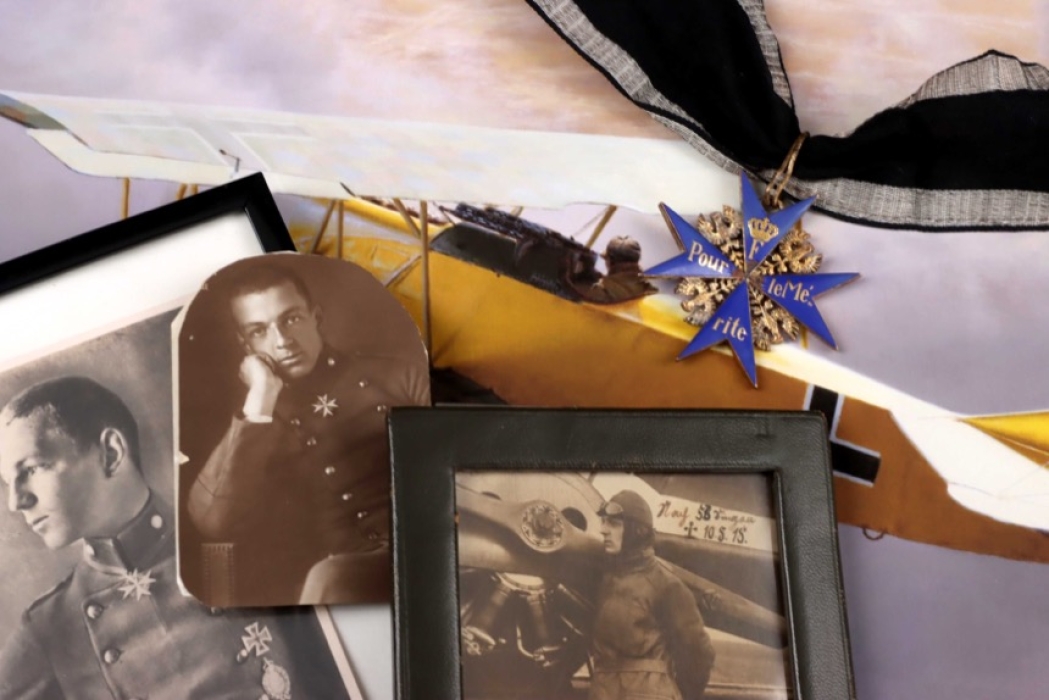
Prussia - Pour le Mérite Erich Löwenhardt 54 Victories
MILITARIA PRICE GUIDE
How can I see prices?
Welcome to the ratisbon's MILITARIA PRICE GUIDE!
To access all prices, pictures, and descriptions please subscribe to our MILITARIA PRICE GUIDE at www.ratisbons.com/militaria-price-guide. Save 25% when subscribing for one year! Get full access for just 75€!
We are buying single items and entire collections! Call +49 8541 9053699
-
MEDALNET APPRAISAL SERVICES
-
MEDALNET APPRAISAL SERVICES
MEDALNETSERVICES.COMThis item was examined and validated in cooperation with MEDALNET APPRAISAL SERVICES. Our team’s knowledge base received the most competent boost for orders and decorations for imperial orders and decorations with the help of Bernd Kruse and Andreas M. Schulze Ising. Andreas and Bernd are held in high regard with collectors around the world. With more than 50 years of experience in the field of order decorations and medals, they are seen as competent and independent experts.
GUARANTEEAs usual, we offer a full right of return for originality within the withdrawal period for items that are offered in cooperation with MEDALNET APPRAISAL SERVICES.
MEDALNET APPRAISAL SERVICES
-
-
PAYMENT
-
HOW CAN I PAY FOR MY ORDER?
AUCTIONSYou will receive an e-mail confirming your successful bids the day after the auction has ended. In your personal my ratisbon's you will be able to inform us about your most convenient payment method for this order or tell us about an alternative shipping address.
If we don’t hear from you within 24 hours, we will send an invoice choosing the payment and shipping options which we think are the most comfortable ones to you. If you decide to change your shipping or payment method after receiving your invoice, just drop us a line or visit my ratisbon's/ORDERS for any more details.
SHOP ORDERSChoose your payment method when ordering and submit your order. Once your order has been received we will send an invoice including your shipping costs and your payment instructions.
After receiving the invoice, the order must be paid within 7 days.
Please contact us to discuss layaway options.To learn more about paying at ratisbon's, please see your FAQ pages.
WE ACCEPT FOLLOWING PAYMENT METHODS
-
-
Versand
-
HOW DO YOU SHIP MY NEW TREASURES?
PACKING & TRACKINGWe usually send out orders within 1-3 working days after your payment has been received. In most cases, we are faster than this! We will inform you when your goods are being dispatched and provide a tracking number, In addition, you can always check your order status at my ratisbon's/ORDERS. Delivery times will vary depending upon the delivery destination and type of shipping service you have chosen.
SHIPPING TO ALTERNATIVE ADDRESSIf you prefer to have your order shipped to your work address or a friend during your absence, we will happy to arrange this for you. Send us an email letting us know about your new shipping address and we will be happy to send an updated invoice to you.
OUR LOGISTIC PARTNERS ARE AS FOLLOWS
-
-
OUR GUARANTEE
-
 OUR GUARANTEE!
OUR GUARANTEE!We only offer collectables which to the best of our specialists knowledge are authentic. About 15% of all consignments are returned to the consignor after extensive research due to authenticity issues.
Unlike traditional auction houses we do offer a full right of return. If you are not satisfied with what you won or bought, you may return it within 14 days. Please inform us and we will instruct you on how to return the goods. For more information, please visit FAQ pages.
Important note: Cancelling bids after an auction may disappoint the consignor, who like you is a collector. This situation is easy to avoid. We encourage you not to bid on any collectable if you are unsure if it fits into your collection. Ask us to cancel your bid 24 hours prior to the end of an auction to avoid this situation.
-
COUNTRY Imperial Germany
DIMENSIONS 53.9 x 53.7 mm
WEIGHT 19.3 g
EAN 2000000837376
PERIOD until 1918
COUNTRY Imperial Germany
COUNTRY Imperial Germany
LOT 73-1557
Cross of the Order
Description
Erich Löwenhardt (April 7, 1897 – August 10, 1918) was a German soldier and military aviator who fought in the First World War and became a fighter ace credited with 54 confirmed aerial victories. Originally enlisting in an infantry regiment even though he was only 17, he fought in the Battle of Tannenberg, winning a battlefield commission on October 2, 1914. He would serve in the Carpathians and on the Italian Front before being medically discharged in mid-1915. He was awarded the Iron Cross 2nd Class, 1914, on October 30, 1914, and the 1st Class in May 1915 for saving the lives of five wounded men. Following a five-month recuperation, Löwenhardt joined the German Air Force in 1916. After serving as an aerial observer and reconnaissance pilot, he underwent advanced training to become a fighter pilot with Jagdstaffel 10 in March 1917. Between March 24, 1917, and August 10, 1918, Löwenhardt shot down 45 enemy airplanes, as well as destroying nine observation balloons. Shortly after his final victory, he was killed in a collision with another German pilot.
Löwenhardt was locked into an “ace race” with Ernst Udet and Lothar von Richthofen for the top scoring ace in their fighter wing as he was part of the Jasta 10, as part of the Jagdgeschwader I. He was awarded the Knight's Cross with Swords of the House Order of Hohenzollern, the Austro-Hungarian Military Merit Cross and most important the Pour le Merite on May 31, 1918, just 2 month and 10 days before his fatal accident. He was one out of 3 German fighter aces that achieved more than 50 aerial victories during WWI.
The Pour le Mérite and accoutrements offered here were consigned directly by his descendants to Ratisbons. The photographs show Erich Löwenhardt clearly wearing the offered cross here. Officially awarded Pour le Mérites were made by either Wagner, Friedländer or Godet in Berlin. This cross has no resemblance to the crosses issued through the orders chancellery, but clearly was the one he wore before his death. The describer has seen this type of cross in photos taken of other recipients (e.g.Albert Müller-Kahle, PlM on October 13, 1918)), mostly in images taken after 1918 during the III.Reich period.
It is highly interesting that this group shows that this type was actually produced before 1918 and awarded in time.
This cross must have been the officially awarded decoration as it is highly questionable that he would have been able to acquire a contemporary wearing copy within the last few days of his life with the war eclipsing in its last year, as no other cross survived within the Löwenhardt estate.
The cross is made from gilded bronze and enamel in hollow fashion like the earlier WWI pieces made by Wagner. It features weep holes within the cross-arm pits necessary to assemble the cross half. Typical chips in the center, the stress zone of the cross. The motto is hand painted onto blue enamel, all eagles were hand finished and highlighted by sawing out excess material. On original 650 mm long neck ribbon.
A rare opportunity to acquire a real piece of history from one of the most successful fighter ace of WWI.
Condition
2
Prince Elector Friedrich of Brandenburg, the later King Friedrich I. of Prussia, created on May 8, 1667, the order “de la Générosité”. After Friedrich II. claimed the Prussian throne in 1740 the order was transformed into the order “pour le mérite”. He did so while striving to elevate Prussia to a major player in Europe needing a true award for merit. Only during the second half of the 18th century the order was mostly awarded to active military personnel. At that time the Prussian army was 150.000 men strong. Friedrich Wilhelm III. changed the regulations of the “pour le mérite” on January 18, 1810, honoring military personnel for merit during combat only, thus it became a true military order. The “pour le mérite” for merit in Science and Arts was consecutively established in 1842. In 1813 however the oak leaf was added as a sign of repetitive or superseded qualification for winning a “pour le mérite”.
The order consisted initially of a blue enameled golden Maltese cross with golden eagles in between each cross arm. The avers showed the crown and cypher “F” for Friedrich on the top cross arm and the name Pour le Mé-, rite starting from the left cross arm to the right ending on the bottom.
In its existence a total of approximately 5750 decorations were awarded in all its models and variations. Out of the total number of awards about 900 go back to its founder Friedrich II. or “the Great” over a time span of 46 years, his successor Friedrich Wilhelm II. however, managed to award a similar number during a reign of only 11 years. The highest number of awarded “pour le mérite’s” came under the reign of Friedrich Wilhelm III. from 1797 to 1840.
Friedrich Wilhelm IV. added a golden crown for those recipients wearing the esteemed order for 50 years in 1844. He also re-established the value of the order “pour le mérite” by adding the swords to the Red Eagle Order, resulting in only 28 awards during the war of 1848/49. He did award only 32 during his reign. Wilhelm I. added the grand cross in 1866 and the oak leaf to the grand cross in 1873. He awarded about 300 decorations in his lifetime. Friedrich III. as the bearer of the grand cross saw no reason to award the “pour le mérite”. Wilhelm II. changed the practice of awarding orders and medals in general, including those of the order “pour le mérite”. He found only about 850 reasons to honor citizens and foreigners alike.
With the First World War degenerating into a long and costly trench warfare, precious raw materials grew scarce. Even the materials used for medals and decorations became subject to strict scrutiny. Following similar proclamations in other German states, Prussia mandated that medals and decorations should be made from replacement materials. The General Orders Commission ordered on October 10, 1916, that gold-based decorations should be crafted only from gilt silver with a silver content of 938/1000. By Prussian law those decorations had to be marked with the content mark 938 and the manufacturers control mark.
The order “pour le mérite” takes a special place amongst all awards for bravery within the German states and is well known worldwide as “Blue Max” as a homage to Max Immelmann, the first recipient of a “pour le mérite” within the German air force.

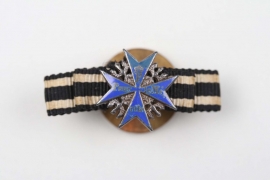
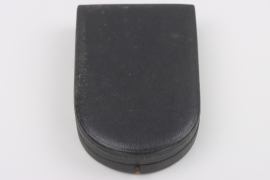
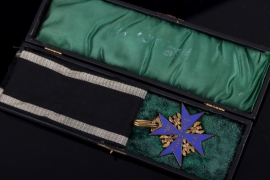

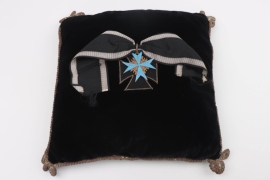
.jpg)

